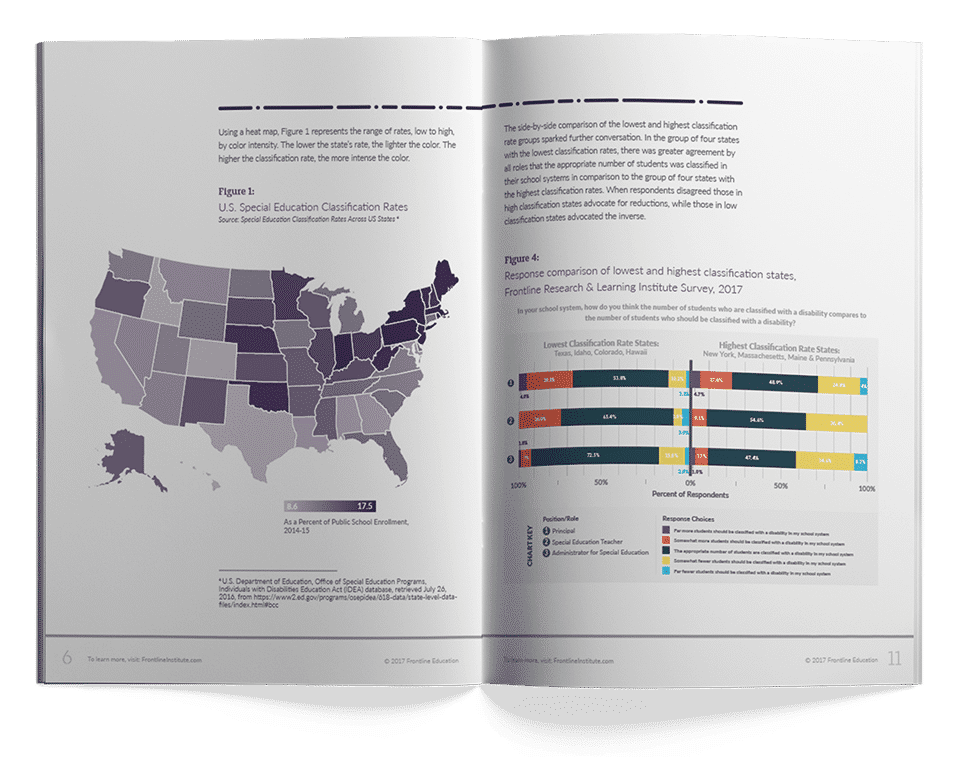Frontline Research & Learning Institute launches new series; first report finds state practices are highly varied but educators largely believe students in their states are properly classified.
MALVERN, PENNSYLVANIA – September 7, 2017 – The Frontline Research & Learning Institute today announced the release of a new report series focused on equity in special education classification rates for students across the country. A majority of surveyed education professionals believe that their state has classified an appropriate number of students for special education services, despite states having significantly different classification rates and criteria, according to the first report in the four-part report series.
The report, titled “Crossing the Line”, is based on a survey of over 3,600 educators in 19 different educational positions across their 12,000 educational organizations to analyze educators’ perceptions about the appropriateness of special education classifications by schools around the United States. The research series aims to provide actionable insights that inform discussion about how states and local districts equitably address the needs of students.
Data from the survey revealed that a majority (56%) of participants believe the appropriate number of students are classified as special education students, while 21% said that somewhat fewer students should be classified as having learning-related disabilities in their school system. Notably, when respondents disagreed about their state’s classification rate, participants in high classification states advocated for reductions, while those in low classification states advocated for increases in classifications.
“IDEA has provided states with increased flexibility that resulted in special education identification and classification rates varying dramatically from state to state, it’s important to analyze and understand how teachers and administrators are responding to and perceiving their state’s standards,” said Dr. Thomas Reap, co-author of the report and Executive Director of Special Education and Interventions at Frontline Education. “With this report, we have discovered that variation in special education classification across the country doesn’t necessarily mean educators disagree with who gets identified.”
In addition to analyzing how superintendents, administrators, teachers, and related service providers perceive their state’s classification rate, the report also examined how classification rates vary from state to state and region to region. According to the findings, states with the highest classification percentages, such as New York, Massachusetts, Maine, and Pennsylvania, are clustered in the Northeast, while states with the lowest classification percentages, such as Texas, Idaho, Colorado, and Hawaii, are spread across the country. Participants from the four states with the lowest classification rates were more likely to agree that the appropriate number of students were classified in their school systems whereas respondents in the four states with the highest classification states were less likely to agree that the right number of students were classified.
Respondents across the board agreed that there are a number of contributing factors to perceived under and over-classification such as the extent to which “Response To Intervention” (RTI) being promoted by the reauthorization of IDEA as a multi-tiered approach to the early identification and support of students with learning and behavior needs actually translates to classification. Students who are identified for support early may never get classified for special education.
“Beyond identifying how state special education classifications are perceived, we also found that, despite our survey revealing substantial differences in opinion regarding whether the correct number of students were being classified for special education, our respondents consistently identified a few key factors that caused them and their peers to perceive under and over-classification,” said Jo Ann Hanrahan, co-author of the report and Frontline Director of Research and Data Analysis. “We’re looking forward to continuing to explore these issues in our research over the next year.”
“Crossing the Line” is available for download here. Over the next year, The Frontline Research and Learning Institute plans to release three additional reports.
About the Frontline Research & Learning Institute:
The Frontline Research & Learning Institute is a division of Frontline Education, an integrated insights partner to K-12 organizations nationwide. The Institute is a learning organization dedicated to providing data-driven research, resources, and observations to support and advance the educational community. Driven by the vast amount of records across Frontline’s comprehensive solutions portfolio, the Institute leverages data from more than 12,000 educational organizations and several million users to reach findings and provide benchmarks that inform strategic decision-making for the education community. The Frontline Research & Learning Institute works with Johns Hopkins Center for Research and Reform in Education to ensure all research reports and analyses are rigorously-validated and representative of national data.
Learn more at www.frontlineinstitute.com
